Raijin: Shinto God Of Thunder And Lightning With Three Fingers Representing Past, Present And Future
A. Sutherland - AncientPages.com - In Japanese mythology, Raijin (Raiden) is one of the eight gods of thunder and master of lightning. His attribute is a sacred Taiko drum. He is commonly represented together with his brother, Fujin, the god of the wind, but his personal companion is Raiju (“thunder animal” or “thunder beast”).
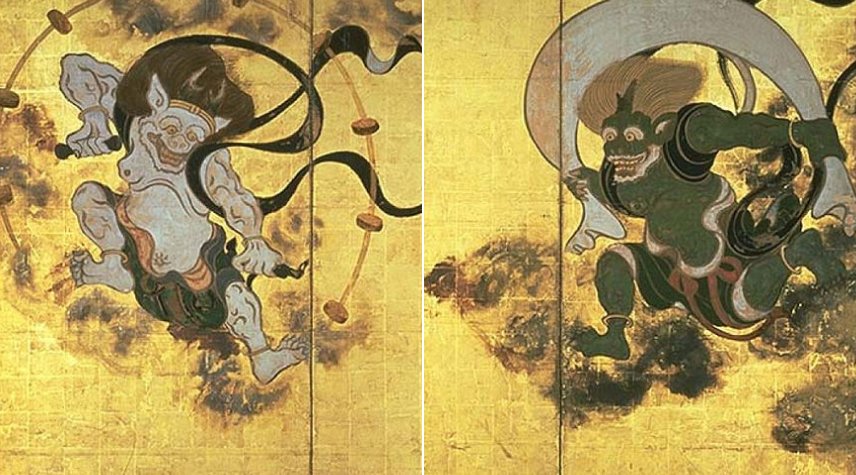 Thunder God Raijin and Wind God Fujin. Kyoto National Museum. source
Thunder God Raijin and Wind God Fujin. Kyoto National Museum. source
The beast is described as looking like a cat, badger, ball of fire, ball of lightning, weasel, monkey, Tanuki (Japanese raccoon dog), a white and blue wolf, and a wolf wrapped in lightning (its body is made of lightning and its cry sounds like thunder).” 1
Raiju is a demonic creature, usually harmless and calm, but he loses his temper only during thunderstorms. He then becomes extremely agitated, leaping around in trees, open spaces, and among buildings. In Shinto beliefs, trees struck by lightning were said to have been scratched by Raiju's claws. Another Raijin’s companion is a thunderbird Raicho, a pine dweller, which – as myths tell – is often sighted flying through a stormy sky.
Our knowledge of the god Raijin comes from Kojiki ("Records of Ancient Matters"), written in 673-686 AD. It is the oldest Japanese book and the most complete collection of Japanese Shinto myths, oral traditions, and historical accounts dating back to 641 AD.
In the early Shinto beliefs, the central deities and creator gods, Izanagi and Izanami, are the parents of Raijin, who was born from Izanami's corpse when she was in the land of darkness (Yomi).
 Wooden Sculpture of Raijin at Sanjusangendo Temple. source
Wooden Sculpture of Raijin at Sanjusangendo Temple. source
Raijin’s brothers include Fujin, the god of wind carrying a large windbag, Susanoo (the god of the sea and storms), Amaterasu (the goddess of the sun), and Kagutsuchi (the god of fire). But he also has many other siblings.
Fujin and Raijin are brothers and friends busy to control the climates of the universe, which is why they are usually represented together. But at the time before humans appeared on Earth, a fight arose between them for control of the storms. As a result, Fujin cut Raijin's left arm, but later, when the conflict was over, they were friends again.
Their sister Amaterasu returned Raijin his arm so they could play the sacred taikos again and generate lightning and thunder.
Raijin’s Three Fingers Symbolize Past, Present And Future
This demonic deity has a muscular, strong body, a frightening face with bulging eyes, hair standing on end, and large fangs. He has three fingers on each hand, symbolizing the past, present, and future.
His drum was used to beat out the terrifying noise of earthquakes and storms in the sky, accompanied by the sound of thunder.
Buddhist temple Sanjusangen-do. Inside the hall, the temple's principal image, a seated Thousand-Armed Kannon statue (a national treasure) is flanked by 500 standing Kannons on each side, for a total of 1000 enshrined statues (all national treasures). In front of the standing Kannon statues are Nijuhachibushu (28 Legions, protecting the Kannon deity) and Fujin and Raijin statues are among them. Image source
In Japanese temples and shrines, Raijin is traditionally depicted as a warrior figure or a protecting divinity. Two famous statues of Raijin and Fujin are among all the others in the group of 28 statues of guardian deities surrounding one thousand life-size statues of the Thousand Armed Kannon at the old (dated to 1164) and prominent Buddhist temple Sanjusangen-do located in Kyoto, Japan.
The Raijin and Fujin sculptures are made of wood with lacquer, gold leaf and painted along with crystal, inlaid eyes, and considered national treasures of Japan.
God Of Thunder And Lightning – A Powerful Deity In Many Cultures
Raijin has many counterparts around the world. Tradition has it that storms, thunder, and lightning were often associated with the highest gods who could manipulate and control forces of nature. In many cultures, thunder was believed to be a creative force and a precursor to life-giving. Based on an old belief, rain is vital for the crops to grow and lightning fertilizes crops.
Myths and legends of Yoruba say that the greatest warrior-king, Shango, became the god of thunder, lightning, and storms after he died. Zeus (Roman god Jupiter) was traditionally regarded by the Greeks as the sender of thunder and lightning, rain, and winds, and while his weapon was the thunderbolt, the Shinto god spirit Raijin uses the Japanese Taiko drums to create the sound of thunder. In the Inca’s beliefs, Catequil (or Apocatequil), the god of thunder and lightning, was believed to create thunder by striking the clouds with his sacred spear and a mighty club. Indra used a powerful thunderbolt to throw light, and Thor, the protector of mankind in Norse beliefs, is a hammer-wielding god associated with thunder, storms, lightning, trees, and strength.
Raijin was both feared and venerated as a good protector of mankind, despite his terrifying appearance.
Raijin’s Furious Storms Stopped Mongol Invasion
According to tradition, Raijin protected the Japanese people from the conflicts and chaos initiated by China’s Kublai Khan.
Raijin helped stop the attempted Mongol invasion of Japan in 1274 by creating Kamikaze ("Divine wind"), the typhoon that stopped the Mongol's dangerous advance and saved Japan during the Mongol attacks.
These events would have taken place in 1281 as well as in 1274.
The term ‘kamikaze’ was later used by the Japanese during the Pacific War (1941-1945) to designate the pilots of suicide planes who were supposed to destroy the American invasion fleet before it reached the coasts of the archipelago.
Updated on August 23, 2024
Written by – A. Sutherland - AncientPages.com Senior Staff Writer
Copyright © AncientPages.com All rights reserved. This material may not be published, broadcast, rewritten or redistributed in whole or part without the express written permission of AncientPages.com
Expand for referencesReferences:
- Hadland Davis, Myths and Legends of Japan
Bane, T. Encyclopedia of Beasts and Monsters in Myth, Legend and Folklore
More From Ancient Pages
-
 Unique Belongings Of Bronze Age Warrior Offer Evidence Of Massive Violent Conflict In Europe
Archaeology | Oct 18, 2019
Unique Belongings Of Bronze Age Warrior Offer Evidence Of Massive Violent Conflict In Europe
Archaeology | Oct 18, 2019 -
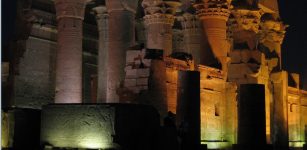 Two Discoveries Reported From Komombo Temple And Elephantine Island, Aswan
Archaeology | Dec 9, 2017
Two Discoveries Reported From Komombo Temple And Elephantine Island, Aswan
Archaeology | Dec 9, 2017 -
 Viking Treasures Discovered In Chamber Grave In Denmark
Archaeology | Apr 4, 2014
Viking Treasures Discovered In Chamber Grave In Denmark
Archaeology | Apr 4, 2014 -
 Where Does The Expression “Pyrrhic Victory” Come From?
Ancient History Facts | Apr 18, 2018
Where Does The Expression “Pyrrhic Victory” Come From?
Ancient History Facts | Apr 18, 2018 -
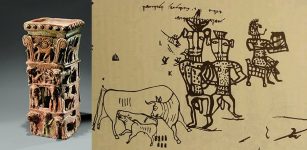 Ancient ‘Yahweh And His Asherah’ Inscriptions At Kuntillet ‘Ajrud Remain An Unsolved Biblical Mystery
Biblical Mysteries | Feb 12, 2021
Ancient ‘Yahweh And His Asherah’ Inscriptions At Kuntillet ‘Ajrud Remain An Unsolved Biblical Mystery
Biblical Mysteries | Feb 12, 2021 -
 Incredible 500,000-Year-Old ‘Paradise’ With Thousands of Artifacts Discovered In Israel
Archaeology | Jan 24, 2018
Incredible 500,000-Year-Old ‘Paradise’ With Thousands of Artifacts Discovered In Israel
Archaeology | Jan 24, 2018 -
 Hidden Story Of The Sacred Wiradjuri Carved Trees Revealed
Archaeology | Nov 28, 2023
Hidden Story Of The Sacred Wiradjuri Carved Trees Revealed
Archaeology | Nov 28, 2023 -
 How Large Was The ‘Giant’ Dunkleosteus Terrelli – Prehistoric King Of The Oceans?
News | Apr 10, 2023
How Large Was The ‘Giant’ Dunkleosteus Terrelli – Prehistoric King Of The Oceans?
News | Apr 10, 2023 -
 Unique Ancient Roman Winery With Marble Tiling And Fountains Of Grape Juice Unearthed In Rome
Archaeology | Apr 17, 2023
Unique Ancient Roman Winery With Marble Tiling And Fountains Of Grape Juice Unearthed In Rome
Archaeology | Apr 17, 2023 -
 Ancient Alaskans Were Freshwater Fishers – Earliest Evidence Found
Archaeology | Jun 19, 2023
Ancient Alaskans Were Freshwater Fishers – Earliest Evidence Found
Archaeology | Jun 19, 2023 -
 History Set In Stone – Maya Rulers Put Their Personal Stamp On Ancient Monuments
Archaeology | Sep 22, 2021
History Set In Stone – Maya Rulers Put Their Personal Stamp On Ancient Monuments
Archaeology | Sep 22, 2021 -
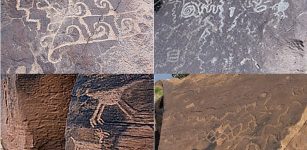 Lyman Lake Petroglyphs And Famous Kokopelli-Flute Player Left By Ancestors Of The Hopi Indians
Civilizations | Nov 26, 2018
Lyman Lake Petroglyphs And Famous Kokopelli-Flute Player Left By Ancestors Of The Hopi Indians
Civilizations | Nov 26, 2018 -
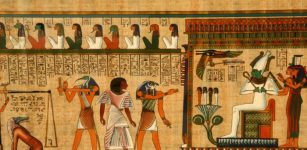 First Book Of Breathing: Egyptian Papyrus Sheds Light On Funerary Text Helping The Deceased In Afterlife
News | Oct 22, 2020
First Book Of Breathing: Egyptian Papyrus Sheds Light On Funerary Text Helping The Deceased In Afterlife
News | Oct 22, 2020 -
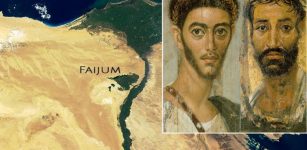 Faiyum Mummies: Long Lost Secrets Of A Mummy’s Portrait
News | Nov 24, 2020
Faiyum Mummies: Long Lost Secrets Of A Mummy’s Portrait
News | Nov 24, 2020 -
 Djémila – Lost City Of The Ancient Kingdom Of Numidia
Featured Stories | Jun 28, 2021
Djémila – Lost City Of The Ancient Kingdom Of Numidia
Featured Stories | Jun 28, 2021 -
 New Models Shed Light On Life’s Origin
DNA | Feb 13, 2023
New Models Shed Light On Life’s Origin
DNA | Feb 13, 2023 -
 Oldest Human Made Architectural Plans Detail Mysterious Desert Megastructures
Archaeology | May 18, 2023
Oldest Human Made Architectural Plans Detail Mysterious Desert Megastructures
Archaeology | May 18, 2023 -
 On This Day In History: Chocolate Was Introduced In Europe – On July 7, 1550
News | Jul 7, 2016
On This Day In History: Chocolate Was Introduced In Europe – On July 7, 1550
News | Jul 7, 2016 -
 Norman Dominance Of Europe Inspired First Crusades In The Holy Land – New Book Claims
History | Sep 8, 2022
Norman Dominance Of Europe Inspired First Crusades In The Holy Land – New Book Claims
History | Sep 8, 2022 -
 Huge Megalithic 7,000-Year-Old Site Dolmen Of Guadalperal Emerges From Dry Lake In Spain
Archaeology | Aug 22, 2022
Huge Megalithic 7,000-Year-Old Site Dolmen Of Guadalperal Emerges From Dry Lake In Spain
Archaeology | Aug 22, 2022

